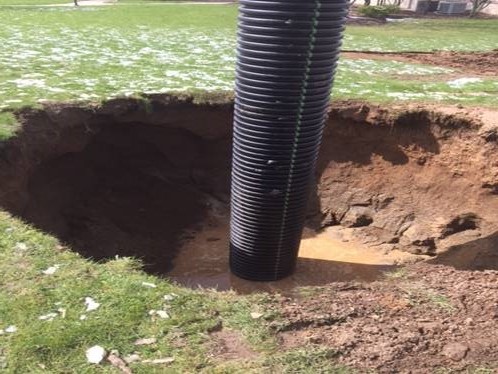Digging Deep – Understanding the Impacts of Poor Soil

 Over the last few years we have had some challenging projects sites to work with. Reclaimed land, below a flood plain, and areas with high moisture content in the soil. Clearly understanding the soil condition at a project site is extremely important before getting too far into the building design process. It is even more important to know how to design to the conditions presented.
Over the last few years we have had some challenging projects sites to work with. Reclaimed land, below a flood plain, and areas with high moisture content in the soil. Clearly understanding the soil condition at a project site is extremely important before getting too far into the building design process. It is even more important to know how to design to the conditions presented.
For any new construction or expansion project, a geotechnical engineering study is strongly advised not only for the building location, but also the parking lot, where underground utilities will run, sidewalks, and other site structures. Neglecting those will undoubtedly cause long term settlement and maintenance issues for your facility.
Take clues from the site:
- Do a little research on the site to see what buildings may have been present there years ago. In many urban areas, chances are there are still portions of those buildings present under the soil. One simple clue is the unevenness of the soil on the site, this would show poor compaction where an old basement may have been filled in.
- Does the building disrupt the sites natural flow of water thru the site or in line with a man-made drainage system? There may be a high content of moisture in the soil, weakening its capacity and could require over excavation, soil stabilization, deep foundations, or dewatering.
- If the site is close to a river basin or low lying area you may be in a flood plain. Checking this basic item out before property acquisition is highly recommended. Many times the soil is extremely poor due to years of flooding and sediment deposits. Building on such a site will likely require improving the soil by removing it, improving it, or installing a geopier like system to stabilize it.
- Has the site been improved to elevate it above a flood plain? It is important to study this building pad and ensure it was constructed properly. If a good pad was built on poor soil the pad will need to be rebuilt.
At the beginning of the project, start with borings around the building foundation as well as a few in the parking lot and where utilities can run. If there is any determination from the geotechnical engineer, noting the potential of poor soils, we recommend two potential solutions to properly understand the extent of the situation:
- Working with the geotechnical engineer to develop a grid pattern on site at a 20-50 foot space to refine the extent of the poor soil condition. Many times when the driller and geotechnical engineer are on site they can establish the grid and work to better understand the conditions.
- Another option is pothole testing using a backhoe. It is the most effective way for the entire design and construction team to visually see the condition of the soil as it is dug up. (note: it is important to do the test outside any known utilities!)
Having this understanding will save time and money during construction by properly designing to conditions below the soil.